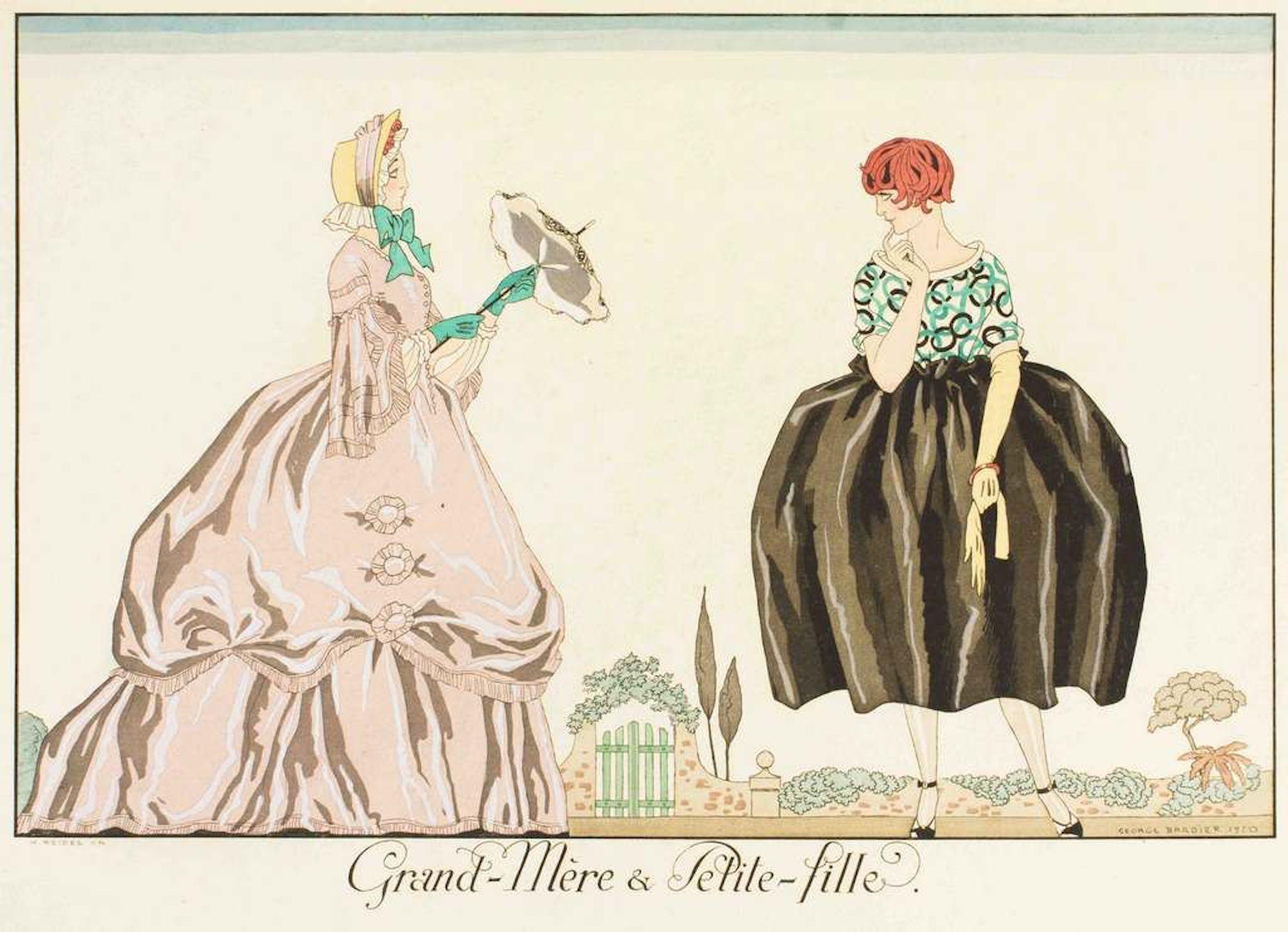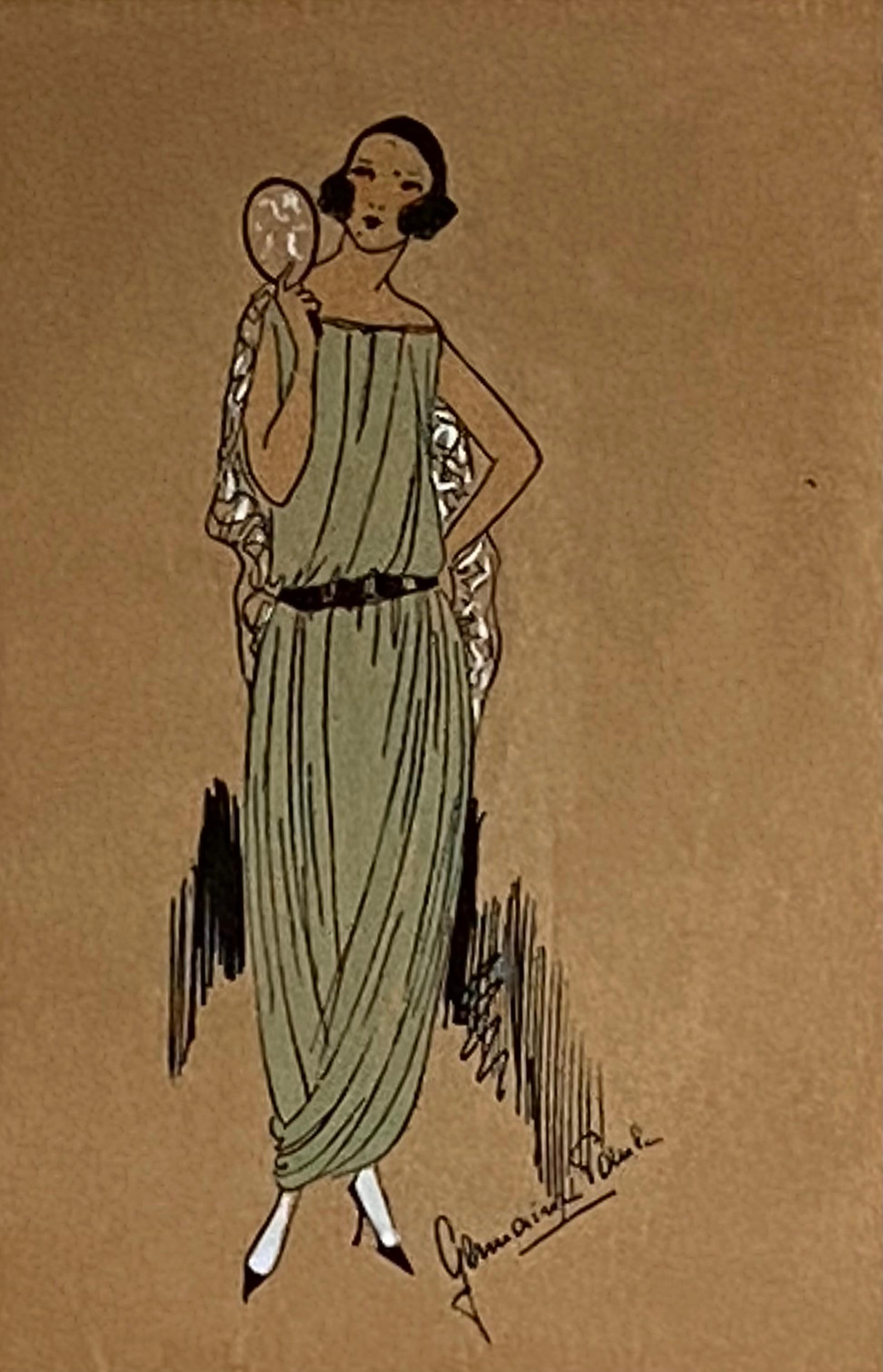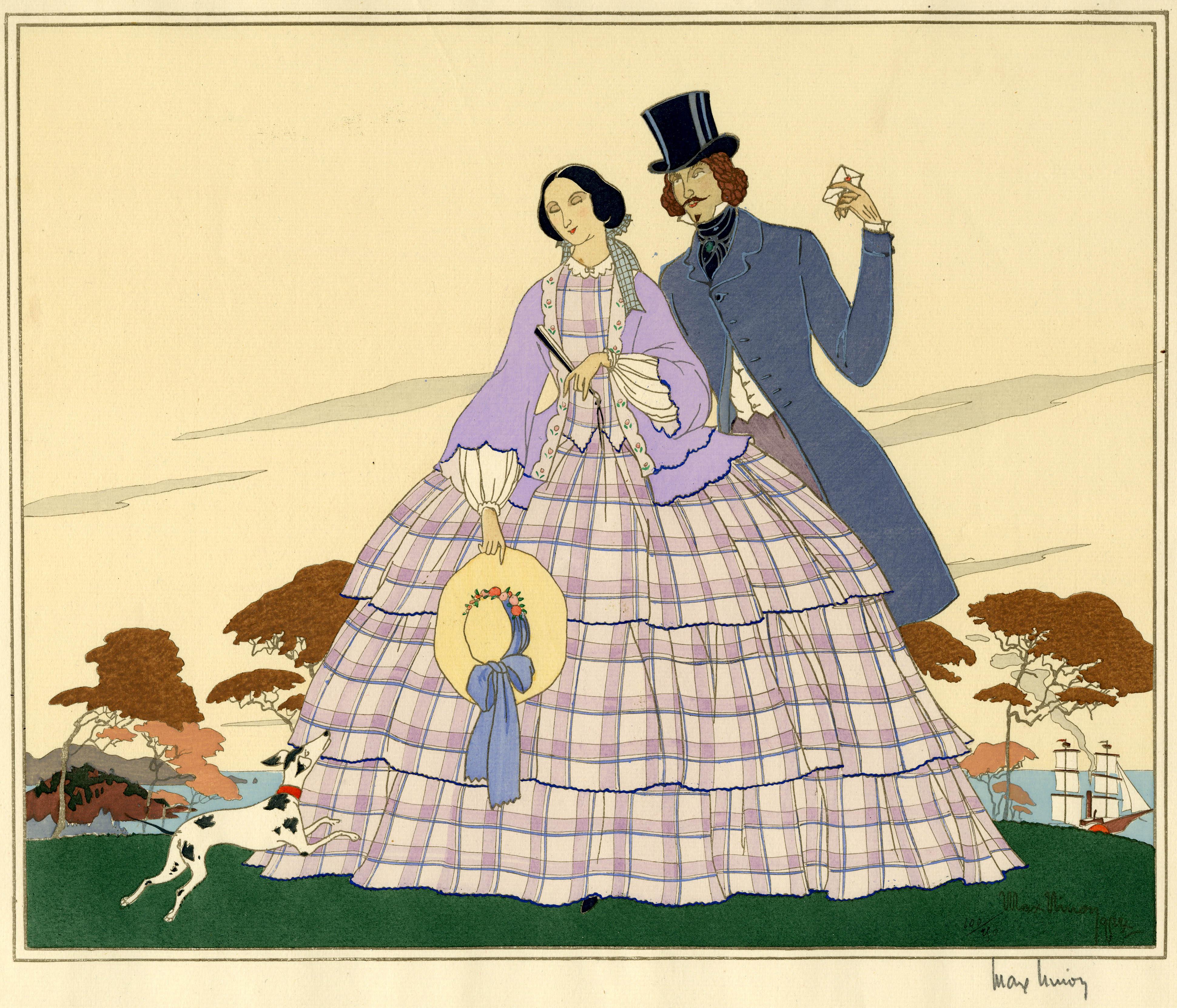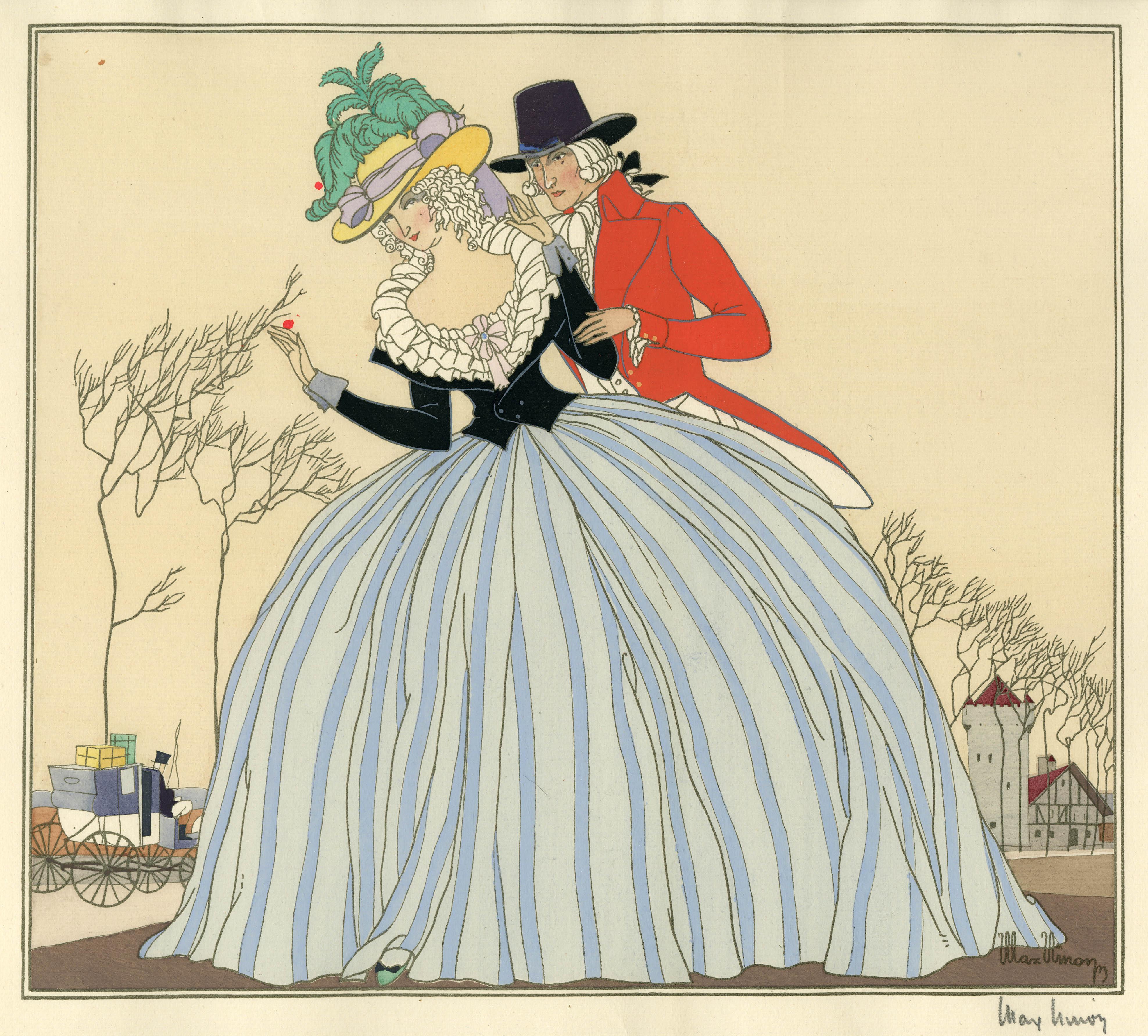Items Similar to Henry Delacroix 'Pharmacie Saint-Lazare a Paris' 1930- Pochoir
Want more images or videos?
Request additional images or videos from the seller
1 of 7
Henry Delacroix 'Pharmacie Saint-Lazare a Paris' 1930- Pochoir1930
1930
About the Item
Paper Size: 14 x 15.5 inches ( 35.56 x 39.37 cm )
Image Size: 8.75 x 10.25 inches ( 22.225 x 26.035 cm )
Framed: Yes
Frame Size:
Condition: A-: Near Mint, very light signs of handling
Supplemental Condition Information: Some small scratches and marks in plexiglas??Additional Details: Pochoir print with silvered ink on strong paper. From the portfolio by H. Delacroix, Boutiques, about 1930. Framed in a metal frame with mat with a front profile of 0.25 inch and side profile of 0.75 inch. Print has not been examined outside of frame.
Shipping and Handling: We ship Worldwide. For Domestic and International shipments alike, we use heavy, thick-walled UPS and FedEx Approved shipping tubes to ship all items that are rollable. For items that cannot be rolled, we pack the item flat.Attention International Buyers, Please Note: Import duties, taxes, and charges are not included in the item price or shipping cost. These charges are the buyer's responsibility. Please check with your country's customs office to determine what these additional costs will be prior to bidding or buying.
- Creation Year:1930
- Dimensions:Height: 14 in (35.56 cm)Width: 15.5 in (39.37 cm)
- Medium:
- Movement & Style:
- After:Henry Delacroix
- Period:
- Condition:All items are carefully stored. Condition is a main concern, unless otherwise indicated, all items are in mint condition. Additional pictures are available upon request. Feel free to contact our team if you have any questions or concerns. Thank you.
- Gallery Location:Brooklyn, NY
- Reference Number:
About the Seller
4.9
Platinum Seller
These expertly vetted sellers are 1stDibs' most experienced sellers and are rated highest by our customers.
Established in 1992
1stDibs seller since 2019
1,859 sales on 1stDibs
Typical response time: 1 hour
- ShippingRetrieving quote...Ships From: Brooklyn, NY
- Return PolicyA return for this item may be initiated within 14 days of delivery.
More From This SellerView All
- Henry Delacroix 'Pharmacie' 1930- PochoirBy Henry DelacroixLocated in Brooklyn, NYPaper Size: 16.25 x 13 inches ( 41.275 x 33.02 cm ) Image Size: 11 x 7.75 inches ( 27.94 x 19.685 cm ) Framed: Yes Frame Size: Condition: A-: Near Mint, very light signs of handling...Category
1930s Art Nouveau Prints and Multiples
MaterialsStencil
- 1994 Gustav Klimt 'Idylle'By Gustav KlimtLocated in Brooklyn, NYPaper Size: 23.75 x 35.5 inches ( 60.325 x 90.17 cm )_x000B_Image Size: 21 x 33 inches ( 53.34 x 83.82 cm )_x000B_Framed: No_x000B_Condition: B: Very Good Condition, with signs of ha...Category
1990s Art Deco Prints and Multiples
MaterialsOffset
- 1897 Otto Fischer 'Dresden, Die Alte Stadt'Located in Brooklyn, NYPaper Size: 8.25 x 11.5 inches ( 20.955 x 29.21 cm ) Image Size: 6 x 8.5 inches ( 15.24 x 21.59 cm ) Framed: No Condition: A: Mint Additional Details: First printing Lithograp...Category
19th Century Art Deco Prints and Multiples
MaterialsLithograph
- Pierre Fix-Masseau-Exactitude-40" x 25"-Lithograph-1982-Vintage-Black, BrownBy Pierre Fix-MasseauLocated in Brooklyn, NYReproduction in lithography of Fix-Masseau Exactitude. Copyrighted 1982 Studio Editions. Printed in France by Bedos on heavy linen like paper.Category
20th Century Art Deco Prints and Multiples
MaterialsLithograph
- 1989 A.M. Cassandre 'L'Oiseau Bleu'Located in Brooklyn, NYPaper Size: 34.75 x 23 inches ( 88.265 x 58.42 cm ) Image Size: 31.5 x 19 inches ( 80.01 x 48.26 cm ) Framed: No Condition: B-: Good Condition, Signs of Handling and Age Supplemental...Category
1980s Art Deco Prints and Multiples
MaterialsLithograph
- 1897 After Emile Berchmans 'L'Art Independant'By Émile BerchmansLocated in Brooklyn, NYPaper Size: 11.5 x 8.25 inches ( 29.21 x 20.955 cm ) Image Size: 7.75 x 6 inches ( 19.685 x 15.24 cm ) Framed: No Condition: A: Mint Additional Details: First printing Lithogr...Category
19th Century Art Deco Prints and Multiples
MaterialsLithograph
You May Also Like
- Grand-mere et Petite-fille - Pochoir by G. Barbier - 1920By George BarbierLocated in Roma, ITThis pochoir belongs to the portfolio 'Le Bonheur du Jour', by George Barbier. A very fine work of one of the most important and famous european illustrators of Art Deco, whose infl...Category
1920s Art Deco Figurative Prints
MaterialsStencil
- L'apres-midi d'un Faune - Pochoir by G. Barbier - 1920By George BarbierLocated in Roma, ITThis is one of the artworks in the portfolio 'Le Bonheur du Jour', by George Barbier. A very fine work of one of the most important and famous european illustrators of Art Deco, who...Category
1920s Art Deco Figurative Prints
MaterialsStencil
- “Sylvia”Located in Southampton, NYOriginal fashion illustration for Tres Parisien, December, 1921 Moroccan Crepe Dress by Germaine-Paule Joumard, Fashion Art Deco Pochoir on Chinese Paper. Artwork size is 7.5 by 5 i...Category
1920s Art Deco Figurative Prints
MaterialsArchival Paper, Stencil
- Frontispiece for Le Bonheur du Jour - Pochoir by G. Barbier - 1929By George BarbierLocated in Roma, ITLe Bonheur du Jour by George Barbie (Nantes, 1889 - Paris, 1932) is an artwork realized in 1929. Original colored pochoir on cardboard. Perfect conditions. Le Bonheur du Jour is...Category
1920s Art Deco Figurative Prints
MaterialsStencil
- CoquetteBy Victor Max NinonLocated in Fairlawn, OHCoquette Pochoir (silk screen) printed in colors, c. 1923-1925 Signed by the artist in pencil lower right; numbered in ink on the image, (see photo) Edition: 250 (100/250) in pencil in image (see photo) Image size: 10-1/2 x 12-3/4" The artist won a gold medal in Paris in 1925 for his porchoirs Victor Max Ninon (Vittorio Accornero de Testa, Italian, 1896-1982) Biography Vittorio Accornero de Testa was born in Casale Monferrato in 1896. He completed his first studies at the "Leardi" institute, but was forced to interrupt them due to the war events of the First World War . At 19 he was second lieutenant of the Alpine troops and in 1916 he took one of the first pilot's licenses. During the war he knows the bitterness of shooting down in air combat (for which he is decorated), but also the good fortune to stay alive, albeit with a disability. His art blossomed in the postwar period, first signing his works simply Ninon and then, probably at the suggestion of a French publisher, under the pseudonym of "Victor Max Ninon" (Victor and Max indicate strength and masculinity, Ninon boyhood) .In 1919 and 1924 he made illustrations for theGiornalino della Domenica , also together with his first wife Edina Altara , for Ardita and La Lettura . In 1923 he won the cover competition organized by the magazine El Hogar of Buenos Aires and in 1925 with his pochoirs he imposed himself in Paris at the international exhibition of modern decorative and industrial arts , obtaining a gold medal. In the same year he made two covers for the US magazine The Smart Set . In the 1920s he made numerous series of art deco style postcards for the Milanese publishing house Degami . On June 4, 1929, aGenoa embarks on the Conte Grande together with his wife Edina Altara , for New York . The two stayed in the American metropolis for a few months: in this period Accornero worked on the creation of theatrical sets and created some covers for Country Life magazine . Accornero gets awards and prizes, but the great economic crisis of the time and the nostalgia for Italy convince the two to return to their homeland, where they resume their activity as illustrators. In 1934 Accornero moved to Milan, separated amicably from his wife and continued to dedicate himself to the illustration of children's books, abandoning the pseudonym Victor Max Ninon. It illustrates about 60 books, from the fables of Andersen , Perrault and Grimm , to the tales of Poe , as well as the famous Pinocchio and Cuore published by Mondadori, Mursia, Hoepli, Martello. Several books illustrated by Accornero have been published in French, Spanish, German and English. In addition to the periodicals already mentioned, he collaborates on the first edition of the Encyclopedia of Boys , Mondadori, and with the Italian magazines Lidel , Il Secolo XX, The Italian Illustration , Fantasies of Italy , The Woman , Cordelia , For You Lady , Grace , Metropolis , La Domenica del Corriere , The Corriere dei Piccoli . In 1936 enters the world of cinema, creating sets and costumes for Wedding Vagabonde of Guido Brignone and The White Squadron of Augustus Genina . From 1935 to 1950 he also devoted himself to the theater, taking care of sets and costumes for numerous operettas, ballets and performances at the Scala in Milan and for the Milanese theaters Manzoni, Lirico and Olympia. Stages Marcello di Giordano, Nina pazza d'amore by Paisiello, I cantori di Nurimberga by Wagner, La Bohème by Puccini and other works. For this activity he is also cited in the Theater encyclopedia. In the 1940s and 1950s he wrote and illustrated six books for children for Mondadori: Tomaso (1944), Giacomino (1949), Tomaso Cacciatore (1950), Zio Stefano (1950), In Campagna che delizia! (1953), Tomaso, dear Tomaso (1955). His illustrations of Perrault's Tales published in those years by Hoepli are famous. His art in the fifties evolves towards hyperrealism . There are many personal exhibitions in Italy and abroad, including those at the Gallerie Gussoni (1959) and Bolzani (1963 and 1966) in Milan and Walcheturm (1962) in Zurich. Eminent critics praise his work, from Orio Vergani to Enrico Piceni, from Reto Roedel to De Chirico himself. On the Domenica del Corriere , the journalist, writer and painter Dino Buzzati...Category
1920s Art Deco Figurative Prints
MaterialsStencil
- Robe GriseBy Victor Max NinonLocated in Fairlawn, OHRobe Grise Pochoir (silk screen) printed in colors, 1923 Signed by the artist in pencil lower right (see photo) The artist won a gold medal in Paris in 1925 for his pochoirs Condition: Two spots in the upper left corner associated with the printing. Victor Max Ninon (Vittorio Accornero de Testa, Italian, 1896-1982) Biography Vittorio Accornero de Testa was born in Casale Monferrato in 1896. He completed his first studies at the "Leardi" institute, but was forced to interrupt them due to the war events of the First World War . At 19 he was second lieutenant of the Alpine troops and in 1916 he took one of the first pilot's licenses. During the war he knows the bitterness of shooting down in air combat (for which he is decorated), but also the good fortune to stay alive, albeit with a disability. His art blossomed in the postwar period, first signing his works simply Ninon and then, probably at the suggestion of a French publisher, under the pseudonym of "Victor Max Ninon" (Victor and Max indicate strength and masculinity, Ninon boyhood) .In 1919 and 1924 he made illustrations for theGiornalino della Domenica , also together with his first wife Edina Altara , for Ardita and La Lettura . In 1923 he won the cover competition organized by the magazine El Hogar of Buenos Aires and in 1925 with his pochoirs he imposed himself in Paris at the international exhibition of modern decorative and industrial arts , obtaining a gold medal. In the same year he made two covers for the US magazine The Smart Set . In the 1920s he made numerous series of art deco style postcards for the Milanese publishing house Degami . On June 4, 1929, aGenoa embarks on the Conte Grande together with his wife Edina Altara , for New York . The two stayed in the American metropolis for a few months: in this period Accornero worked on the creation of theatrical sets and created some covers for Country Life magazine . Accornero gets awards and prizes, but the great economic crisis of the time and the nostalgia for Italy convince the two to return to their homeland, where they resume their activity as illustrators. In 1934 Accornero moved to Milan, separated amicably from his wife and continued to dedicate himself to the illustration of children's books, abandoning the pseudonym Victor Max Ninon. It illustrates about 60 books, from the fables of Andersen , Perrault and Grimm , to the tales of Poe , as well as the famous Pinocchio and Cuore published by Mondadori, Mursia, Hoepli, Martello. Several books illustrated by Accornero have been published in French, Spanish, German and English. In addition to the periodicals already mentioned, he collaborates on the first edition of the Encyclopedia of Boys , Mondadori, and with the Italian magazines Lidel , Il Secolo XX, The Italian Illustration , Fantasies of Italy , The Woman , Cordelia , For You Lady , Grace , Metropolis , La Domenica del Corriere , The Corriere dei Piccoli . In 1936 enters the world of cinema, creating sets and costumes for Wedding Vagabonde of Guido Brignone and The White Squadron of Augustus Genina . From 1935 to 1950 he also devoted himself to the theater, taking care of sets and costumes for numerous operettas, ballets and performances at the Scala in Milan and for the Milanese theaters Manzoni, Lirico and Olympia. Stages Marcello di Giordano, Nina pazza d'amore by Paisiello, I cantori di Nurimberga by Wagner, La Bohème by Puccini and other works. For this activity he is also cited in the Theater encyclopedia. In the 1940s and 1950s he wrote and illustrated six books for children for Mondadori: Tomaso (1944), Giacomino (1949), Tomaso Cacciatore (1950), Zio Stefano (1950), In Campagna che delizia! (1953), Tomaso, dear Tomaso (1955). His illustrations of Perrault's Tales published in those years by Hoepli are famous. His art in the fifties evolves towards hyperrealism . There are many personal exhibitions in Italy and abroad, including those at the Gallerie Gussoni (1959) and Bolzani (1963 and 1966) in Milan and Walcheturm (1962) in Zurich. Eminent critics praise his work, from Orio Vergani to Enrico Piceni, from Reto Roedel to De Chirico himself. On the Domenica del Corriere , the journalist, writer and painter Dino...Category
1920s Art Deco Figurative Prints
MaterialsStencil
Recently Viewed
View AllMore Ways To Browse
Roll Front
Vintage Heavy Metal Art
Art Deco Prints Small
Deco Pochoir
Art Deco Plexiglas
Deco Pochoir Prints
Vintage Woman Poster
White 3d Flower
Large Western Sculpture
Japanese Design Books
Original Bible
Used Military Uniforms
London 19th Century Lithograph
Pablo Picasso 1961
Vintage Japanese Women
American Regionalism Prints
Context Cut
Dora Dora





